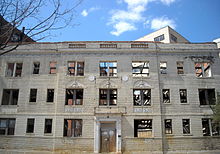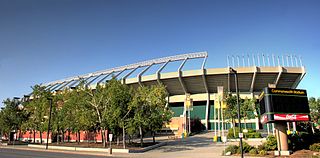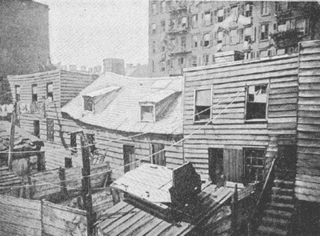
Redevelopment is any new construction on a site that has pre-existing uses. It represents a process of land development uses to revitalize the physical, economic and social fabric of urban space. [1]

Redevelopment is any new construction on a site that has pre-existing uses. It represents a process of land development uses to revitalize the physical, economic and social fabric of urban space. [1]
Variations on redevelopment include:
Redevelopment projects can be small or large ranging from a single building to entire new neighborhoods or "new town in town" projects.
Redevelopment also refers to state and federal statutes which give cities and counties the authority to establish redevelopment agencies and give the agencies the authority to attack problems of urban decay. The fundamental tools of a redevelopment agency include the authority to acquire real property, the power of eminent domain, to develop and sell property without bidding and the authority and responsibility of relocating persons who have interests in the property acquired by the agency. The financing/funding of such operations might come from government grants, borrowing from federal or state governments and selling bonds and from tax increment financing.
Other terms sometimes used to describe redevelopment include urban renewal (urban revitalization). While efforts described as urban revitalization often involve redevelopment, they do not always involve redevelopment as they do not always involve the demolition of any existing structures but may instead describe the rehabilitation of existing buildings or other neighborhood improvement initiatives.
A new example of other neighborhood improvement initiatives is the funding mechanism associated with high carbon footprint air quality urban blight. Assembly Bill AB811 is the State of California's answer to funding renewable energy and allows cities to craft their own sustainability action plans. These cutting edge action plans needs the funding structure; which can easily come forward through redevelopment funding.
Some redevelopment projects and programs have been incredibly controversial including the Urban Renewal program in the United States in the mid-twentieth century or the urban regeneration program in Great Britain. Controversy usually results either from the use of eminent domain, from objections to the change in use or increases in density and intensity on the site or from disagreement on the appropriate use of taxpayer funds to pay for some element of the project. Urban redevelopment in the United States has been controversial because it can displace poor and lower middle class residents, often transferring residents' land and homes to developers for free or a below-market-value price. This is done on the condition that the developer will use that land to construct new commercial and residential developments.
The residents displaced by redevelopment are often undercompensated, [2] and some (notably month-to-month tenants and business owners) are not compensated at all. Historically, redevelopment agencies have been buying many properties in redevelopment areas for prices below fair market value, or even below the agencies' own appraisal figures because the displaced people are often unaware of their legal rights and lack the will and the funds to mount a proper legal defense in a valuation trial.[ citation needed ] Those who do so usually recover more in compensation than what is offered by the redevelopment agencies.
The controversy over misuse of eminent domain for redevelopment reached a climax in the wake of the U.S. Supreme Court's 2005 decision in Kelo v. City of New London , which ruled that the general benefits a community enjoyed from economic growth qualified private redevelopment plans as a permissible "public use" under the Takings Clause of the Fifth Amendment. [3] The Kelo decision was widely denounced and remains the subject of severe criticism. Remedial legislation to restrict the use of eminent domain for private development has been enacted or introduced in a number of states.
Golf course redevelopment, also known as golf course conversion is a real estate niche, in which investors purchase failing golf courses. Investors then subdivide the golf course into individual plots of lands. They then resell the plots of land for builders, or build on the plots then resell it to residential home buyers. This process is usually done with the assistance of a real estate broker.
The main challenge of this niche is the difficulties that investors face in requesting a variance from cities. [4]
North America:
Europe:
Asia:
Central America:

Urban renewal is a program of land redevelopment often used to address urban decay in cities. Urban renewal involves the clearing out of blighted areas in inner cities to clear out slums and create opportunities for higher class housing, businesses, and other developments. In the United States the term technically refers only to a federal program in the middle-to-late 20th Century, but colloquially is sometimes used to refer to any large-scale change in urban development.
Poletown East is an industrial district of Detroit, Michigan, bordering the enclave city of Hamtramck. The area was named after the Polish immigrants who originally lived in the area. A portion of residential area known as Poletown became the General Motors Detroit/Hamtramck Assembly plant in 1981 with those residents relocated by General Motors and the cities of Detroit and Hamtramck which claimed eminent domain in order to make way for a new automobile plant.

Tax increment financing (TIF) is a public financing method that is used as a subsidy for redevelopment, infrastructure, and other community-improvement projects in many countries, including the United States. The original intent of a TIF program is to stimulate private investment in a blighted area that has been designated to be in need of economic revitalization. Similar or related value capture strategies are used around the world.
Berman v. Parker, 348 U.S. 26 (1954), is a landmark decision of the United States Supreme Court that interpreted the Takings Clause of the Fifth Amendment to the United States Constitution. The Court voted 8–0 to hold that private property could be taken for a public purpose with just compensation. The case laid the foundation for the Court's later important public use cases, Hawaii Housing Authority v. Midkiff, 467 U.S. 229 (1984) and Kelo v. City of New London, 545 U.S. 469 (2005).
Kelo v. City of New London, 545 U.S. 469 (2005), was a landmark decision by the Supreme Court of the United States in which the Court held, 5–4, that the use of eminent domain to transfer land from one private owner to another private owner to further economic development does not violate the Takings Clause of the Fifth Amendment. In the case, plaintiff Susette Kelo sued the city of New London, Connecticut, for violating her civil rights after the city tried to acquire her house's property through eminent domain so that the land could be used as part of a "comprehensive redevelopment plan". Justice John Paul Stevens wrote for the five-justice majority that the city's use of eminent domain was permissible under the Takings Clause, because the general benefits the community would enjoy from economic growth qualified as "public use".
Canada Lands Company Limited is a self-financing federal Crown corporation reporting to the Parliament of Canada through Public Services and Procurement Canada. The company is responsible for managing property on behalf of the federal government, conducting public consultation and integrating properties back into their surrounding communities for development. Most of its assets are located in Canadian urban centres, and are sold after the CLC revalued the property by providing managerial support and subsidizing immediate costs such as decontamination. However, the company retains ownership of some of Canada's most valued properties, such as Downsview Park, the CN Tower, the Old Port of Montreal and the Montreal Science Centre, from which it draws rental and hospitality revenues.

Edmonton City Centre Airport (ECCA), also called Blatchford Field as well as Edmonton Municipal Airport, was an airport within the city of Edmonton, in Alberta, Canada.

3rd Canadian Division Support Base Edmonton, formerly known as and commonly referred to as CFB Edmonton is a Canadian Forces base located in Sturgeon County adjacent to the City of Edmonton in Alberta, Canada. It is also known as Edmonton Garrison or "Steele Barracks".

The Boston Planning & Development Agency (BPDA), formerly the Boston Redevelopment Authority (BRA), is a Massachusetts public agency that serves as the municipal planning and development agency for Boston, working on both housing and commercial developments.
The Castle Coalition is a network of U.S. homeowners and citizen activists determined to stop the abuse of eminent domain in their communities, that is, the taking of private property by the government in order to give it to another private individual. The organization takes its name from the principle that Americans' homes or businesses should be their castles, that is, places where they are safe and free from abusive government power. The principle has been part of Anglo-American legal tradition since Edward Coke famously stated, "... a man's house is his castle".

McCauley is an ethnically diverse inner city neighbourhood in Edmonton, Alberta, undergoing revitalization. It is named for Matthew McCauley, the first mayor of Edmonton, and is located just to the north east of the Downtown core. McCauley is known as the home of religious buildings in a small area, as well as being a large venue for the 1978 Commonwealth Games.

California Propositions 98 and 99 were competing ballot propositions in the U.S. state of California to limit the use of eminent domain and possibly rent control. They were voted on June 3, 2008; proposition 98 failed, while proposition 99 passed.

Chris Norby is an American politician and educator. He served on the Fullerton City Council (1984–2002) including three years as mayor, on the Orange County Board of Supervisors (2003–2010), on the California State Assembly (2010–2012).
Las Vegas Redevelopment Agency is a redevelopment agency whose goal is to work in concert with the community and private sector to revitalize the City of Las Vegas.
The Colonial Promenade Alabaster is a lifestyle center that opened in 2005 and is located in Alabaster, Alabama, United States. The 1,000,000-square-foot (93,000 m2) shopping center is the largest in Shelby County and it was developed by Colonial Properties Trust. It was at the center of a nationally publicized controversy over the use of eminent domain to facilitate private commercial development.
The Philadelphia Redevelopment Authority (PRA) was created by the Commonwealth of Pennsylvania's Urban Redevelopment Law of 1945. Until the Fall of 2011 it was known as the Redevelopment Authority of the City of Philadelphia (RDA).
Blatchford is a carbon neutral community being developed on the site of the decommissioned City Centre Airport in Edmonton, Alberta. With an area of 2.17 km2 (0.84 sq mi), Blatchford is approximately the size of Edmonton's downtown core. It is planned to be a medium-high density neighbourhood which will rely on renewable energy and a district energy sharing system, contain two Light Rail Transit (LRT) stations, and be carbon neutral.

The Metro Line is a light rail transit line on the Edmonton Light Rail Transit system. The line operates from northwest Edmonton to south Edmonton, and was scheduled to have begun operation by spring 2014 but instead opened on September 6, 2015, at a reduced speed and frequency. The line uses 3.3 kilometres (2.1 mi) of new track, three new stations, and seven stations on the existing Capital Line. In August 2021, service on the Metro Line was modified to end at Health Sciences/Jubilee station, as was originally planned but delayed due to signalling issues which caused trains to run a reduced frequency to the interim terminus at Century Park station to ensure the Capital Line could run at full frequency. The cost of the project was $665 million, jointly funded by the City of Edmonton, Province of Alberta, and the Government of Canada. It was the first new line that was not an extension of the existing line. The line was expected to add 13,200 riders per weekday. A trip from NAIT station to Churchill is expected to take nine minutes. A number of roadworks are under construction or completed to revitalize the surrounding community. An extension to the northwest city limits has completed conceptual design, and a further extension is proposed through the city of St. Albert on Highway 2/St. Albert Trail.
In the United States, eminent domain is the power of a state or the federal government to take private property for public use while requiring just compensation to be given to the original owner. It can be legislatively delegated by the state to municipalities, government subdivisions, or even to private persons or corporations, when they are authorized to exercise the functions of public character.

Slum clearance in the United States has been used as an urban renewal strategy to regenerate derelict or run-down districts, often to be replaced with alternative developments or new housing. Early calls were made during the 19th century, although mass slum clearance did not occur until after World War II with the introduction of the Housing Act of 1949 which offered federal subsidies towards redevelopments. The scheme ended in 1974 having driven over 2,000 projects with costs in excess of $50 billion.
{{cite journal}}: Cite journal requires |journal= (help)